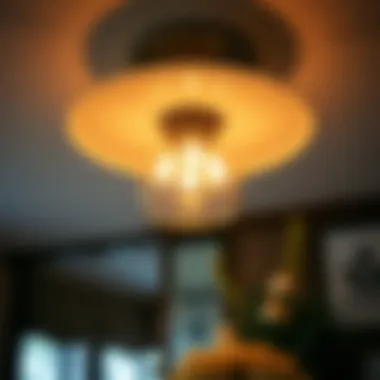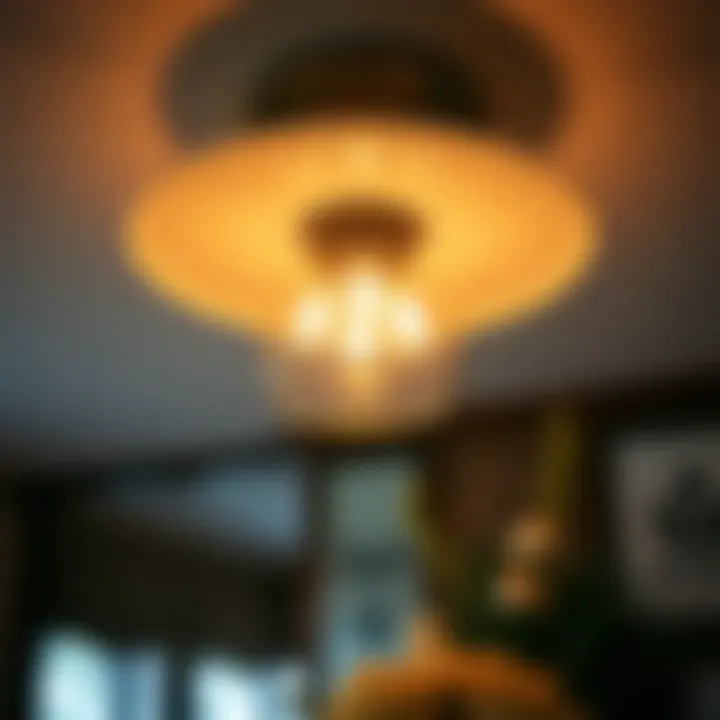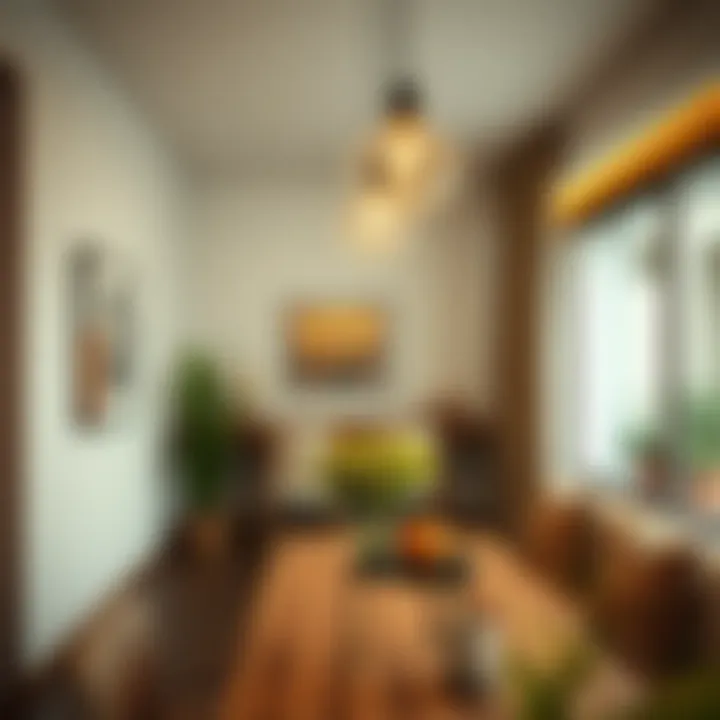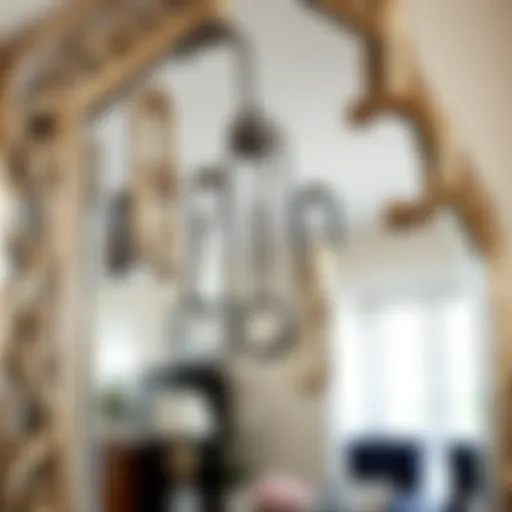Dinette Ceiling Lights: Style and Functionality Insights


Intro
In the realm of home design, the dinette area often serves as a cozy corner where warmth meets functionality. It's not just about devouring breakfast or sharing a meal with family; this space is about creating memories. One of the most crucial elements in enhancing that environment is, without a doubt, lighting. Ceiling lights, in particular, play a pivotal role in setting the mood and elevating the overall aesthetic of a dinette. As we navigate the intricate landscape of dinette ceiling lights, we will explore current design trends, the significance of material choices, and the underlying functionalities that these fixtures serve. With this guide, homeowners, interior designers, and DIY enthusiasts will be well-equipped to make informed decisions that shine a light on the beauty of their dinette spaces.
Design Trends
Lighting design is as diverse as it is dynamic. Today, homeowners increasingly seek fixtures that balance style with practicality. Let’s take a look at some of the prominent design trends that are illuminating dinette spaces.
Contemporary Styles
The modern homeowner often gravitates towards clean lines and minimalist aesthetics.
- Sleek Fixtures: Look for designs that feature geometric shapes or metallic finishes. Think of pendant lights crafted from brushed nickel or copper, which not only provide ample light but also act as sculpture-like statements.
- Layered Lighting: Another contemporary trend is the use of varied heights and types of fixtures. Layering allows for flexible lighting options, catering to different activities and moods, from casual breakfasts to elegant dinner parties.
These design choices reflect a broader cultural movement towards simplicity and functionality, encouraging homeowners to cultivate light-filled, flexible spaces.
Vintage Inspirations
On the flip side, many individuals are embracing the charm of the past. Vintage-inspired ceiling lights can lend a unique character to dinettes, injecting warmth and nostalgia with every glow.
- Retro Designs: Fixtures that recall mid-century modern aesthetics or industrial styles are making a significant comeback. Think of glass globes or Edison bulbs that lend an atmospheric hue.
- Repurposed Materials: Vintage lighting often emphasizes sustainability. Designers are more frequently reimagining old materials to create new masterpieces, breathing fresh life into items that might otherwise be discarded.
It’s fascinating how a touch of retro can transform a modern dinette into a cozy haven steeped in history.
"Light is the magical ingredient that shapes spaces. It enhances not just the visibility but the very essence of a room."
Material Innovations
Beyond the visuals, the materials used in ceiling lights are evolving, opening up possibilities both for style and sustainability.
Sustainable Materials
As environmental concerns grow, so does the demand for sustainable materials in lighting solutions.
- Recycled Metals and Glass: These materials not only reduce waste but can also add industrial flair to your dinette. Using fixtures made from such components can create a conversation starter and elevate the overall aesthetic without compromising on environmental ethics.
- Non-Toxic Finishes: Homeowners are increasingly considering finishes that are free from harmful chemicals, ensuring a safer indoor environment.
Smart Furniture Technology
With the rise of the smart home, lighting fixtures are also getting a digital upgrade.
- Smart Ceiling Lights: Devices that integrate with systems like Google Home or Amazon Alexa allow users to control their lighting with ease. Adjusting brightness and color can greatly enhance the ambience, allowing for tailor-made experiences.
- App Control: Many innovative ceiling lights now come with app features for programming and customizations, making the management of lighting much more intuitive.
As we explore these trends and innovations, it becomes clear that dinette lighting transcends mere illumination—it's an integral part of the home, marrying design and functionality in ways that can be both aesthetic and practical.
Prelims to Dinette Ceiling Lights
In the world of interior design, every element plays a pivotal role in shaping the ambiance of a space. This is especially true for dinette areas, where family gatherings and intimate meals take place. The right lighting can transform a mundane corner into a cozy dining oasis. Dinette ceiling lights are not just fixtures; they are an integral aspect of the overall design and functionality of the dining space. Their importance cannot be overstated, as they provide illumination while enhancing the aesthetic appeal of the area.
The interplay of light and shadow can evoke emotions, dictate the mood for different occasions, and even influence social interactions. For instance, a bright, inviting light may be perfect for a weekend brunch, whereas a softer, dimmer light could set a romantic tone for an evening meal. By choosing appropriate ceiling lights, homeowners can sculpt the ambience to suit various needs, making the choice of lighting fixtures a critical decision in the design process.
Several factors come into play when considering dinette ceiling lights. First, functionality is paramount; these lights must offer sufficient brightness for tasks such as serving food or reading menus. Additionally, they should complement existing decor and furniture styles, ensuring a cohesive look. A careful balance between light intensity, style, and purpose will yield a well-designed dinette that can be enjoyed for years to come.
Whether you’re an avid entertainer or simply enjoy family dinners at home, understanding the nuances of dinette ceiling lights will equip you with the knowledge to elevate your space effectively. This guide will navigate through various styles, functionalities, and trends, ensuring that your choice not only illuminates but also enhances the charm of your dinette area.
The Role of Lighting in Dinette Spaces
Lighting in dinette spaces is much more than just utility; it serves as an emotional backdrop for many life moments. The type of lighting you select can dictate not just visibility but also the overall feel of the environment. A well-placed light can accentuate design features, create focal points, and highlight artwork or decorative elements in the dinette. For example, installing a stylish pendant light above the dining table can not only illuminate the space but draw attention to the setting itself.
Moreover, different activities benefit from varying levels of brightness. Family game nights may require more illumination than a quiet dinner for two. Therefore, flexibility in lighting options can enhance the use of a dinette space. Often, this can be accomplished through a combination of fixed fixtures and portable lighting options, allowing one to adapt the lighting quickly to suit the occasion.
Why Choose Ceiling Lights for Dinette Areas
Ceiling lights hold a unique position in the hierarchy of lighting fixtures. They offer an overhead illumination that can cover a wide area, making them ideal for dinette spaces. Choosing ceiling lights comes with multiple benefits:


- Space Efficiency: Unlike floor or table lamps, ceiling lights free up valuable space on surfaces, making them especially beneficial for smaller dining areas where every inch counts.
- Style Versatility: Ceiling lights come in numerous styles, from sleek flush mounts to elaborate chandeliers, allowing homeowners to express their design preferences without compromising on functionality.
- Enhanced Aesthetics: The right ceiling light can act as a centerpiece for the dinette, adding character and intrigue while also serving practical needs.
Thus, the choice of ceiling lights is often a strategic decision for homeowners who wish to marry style with utility. An informed selection will result in a dinette space that is not only functional but also reflects personal taste and enhances the enjoyment of shared meals.
Types of Dinette Ceiling Lights
Choosing the right ceiling light for your dinette isn't just about brightness; it's about creating a certain vibe and enhancing the overall aesthetics. Dinette areas are often the hub of social activity in a home, where family and friends gather for meals, conversations, and casual meet-ups. Thus, selecting the appropriate type of ceiling light can transform this space from merely functional into a haven of comfort and style. Here, we’ll look at various types of dinette ceiling lights that cater to different tastes and purposes.
Chandeliers: Elegance and Style
Chandeliers have long been associated with opulence and grandeur. They make a statement, bringing an air of sophistication to any dinette. Contemporary designs often stray from the traditional crystal-laden options, offering sleek lines and minimalist constructions that still command attention.
When considering a chandelier, it's essential to find the right size; it should neither dwarf the table nor seem out of place. A good rule of thumb is to allow approximately 30 inches between the bottom of the fixture and the table surface. Another thing worth mentioning is the height of the ceiling. In a low-ceilinged dinette, a flush-mounted chandelier can work wonders without the risk of it looming too low.
"The right chandelier can turn a simple dinette into a delightful setting where memories are created over shared meals."
Flush Mount Lighting: Sleek Simplicity
Flush mount ceiling lights are a fantastic option for those who appreciate clean lines and minimal fuss. They sit snugly against the ceiling, making them perfect for spaces with lower ceilings. This lighting type offers streamlined functionality without drawing too much attention itself.
Available in various designs, flush mounts can fit a range of decor styles, from modern to rustic. They provide ample light and are easily compatible with dimmers, allowing you to adjust the brightness to set the desired mood.
If you're working with a smaller dinette or a space that prioritizes simplicity, flush mounts can truly shine, keeping the area uncluttered yet inviting.
Pendant Lighting: Versatile and Contemporary
Pendant lights are a good choice if you’re looking to add a contemporary flair to your dinette while retaining flexibility in design. They hang from the ceiling, allowing for varying heights and placements, which can help create a cozy atmosphere.
These fixtures come in a myriad of styles, colors, and shapes. Whether you prefer a single, bold pendant or a cluster of smaller ones, they provide excellent focal points over dining tables. When arranging pendant lights, think of the spacing between fixtures. Keeping them approximately 24 inches apart will help maintain visual balance.
Considerations for Installation:
- Make sure to hang them low enough to provide adequate light, typically 28-34 inches above the tabletop.
- Use multiple pendants for larger tables to ensure the light is evenly distributed.
Track Lighting: Directional Flexibility
Track lighting is the unsung hero in the world of ceiling lights, offering not just illumination but also flexibility. This system consists of various fixtures connected to a horizontal track fixed to the ceiling, allowing you to direct light exactly where it’s needed.
In a dinette, track lights work well to highlight specific areas, such as a dining table or a sideboard. They can be adjusted easily, making them a preferable choice for spaces that might serve multiple functions. Whether it’s for that family game night or a romantic dinner for two, track lighting can accommodate various atmospheres.
Benefits of Track Lighting:
- Easy to modify and adapt as your needs change.
- Allows for the use of different bulb types for varied lighting effects.
Culmination
Understanding the types of dinette ceiling lights available is crucial for transforming your dining area into a warm and inviting space. Whether you lean towards elegant chandeliers or the simplicity of flush mounts, the options are plenty. Think about the overall aesthetic of your home, the scale of the dinette, and how you intend to use the space when deciding. The right lighting strikes a balance between functionality and style, creating an atmosphere where memories are made.
Design Considerations for Dinette Ceiling Lights
Choosing the right ceiling lights for a dinette involves much more than picking a fixture that simply looks nice. It’s about balancing aesthetics with functionality, ensuring that the chosen lighting enhances the space’s atmosphere while meeting practical needs. Every element plays a pivotal role, from size and installation height to integration into the overall decor theme. Getting these aspects right can forge a harmonious relationship between light and space, making the dinette an inviting area for both dining and socializing.
Proportions: Matching Scale with Space
When you think about proportions in design, it’s like the Goldilocks principle: not too big, not too small, but just right. Ceiling lights should complement the dimensions of the dinette without overpowering or getting lost. If your dinette is spacious, a large chandelier can work wonders as a focal point. Conversely, in a compact space, opting for flush mounts or smaller pendants ensures the area feels open rather than cramped.
Consider measuring not only the ceiling’s height but also the space around the table. A good rule of thumb is to hang a light fixture about 30 to 36 inches above the tabletop. This maintains visibility while ensuring that the light distributes evenly across the area. A well-measured, proportionate fixture can greatly enhance the overall ambiance, making the dinette area feel carefully curated.
Style Integration: Cohesion Across Design Elements
The design of your ceiling light should echo the broader style of your home. Whether your decor leans towards modern minimalism or charming rusticity, selecting a ceiling light that complements these aesthetics is key. For example, a sleek metal pendant might feel out of place in a vintage-themed dinette that embraces warmer woods and softer tones. Unity in design can be achieved by considering similar materials, colors, and shapes that resonate throughout the space.
Think about pairings as well—perhaps lighting fixtures that feature the same finish as cabinet hardware or dining chair legs. By weaving these threads of design together, your dinette will feel like a cohesive extension of your personal style rather than a disjointed afterthought.


Color Temperature: Setting the Right Mood
Color temperature, a term that might sound technical but is really just about how warm or cool the light appears, can fundamentally affect the mood in your dinette. Lights with a lower color temperature (around 2700K to 3000K) provide a soft, inviting glow that encourages relaxation and social engagement, perfect for family meals. Conversely, a higher color temperature closer to daylight (5000K and above) might be better in settings that require clarity and focus, such as a workspace.
For the dinette, striking a balance is crucial. It might be wise to consider dimmable bulbs that allow you to adjust the ambiance based on activities—bright enough for lively dining, dimmed for a cozy, intimate meal.
Dimming Options: Controlling Ambiance
Dimming capabilities are like having a volume control for your light; they provide flexibility to transition between different moods and occasions. An evening dinner with friends might call for a subtle, lowered light to create a warm atmosphere, while you might prefer higher illumination during breakfast to boost productivity and energy levels. Many contemporary fixtures come with built-in dimmers, or it’s relatively easy to adapt existing setups with smart technology.
Moreover, smart dimmers often allow for integration with home automation systems, giving you remote control or preset settings for different occasions. This thoughtful addition not only enhances usability but can also be a talking point in your overall design strategy.
"Selecting the right ceiling light is as much about function as it is about form. Finding that balance can elevate your dinette from mundane to extraordinary."
When choosing dinette ceiling lights, remember that the interplay between style, functionality, and practical design considerations can transform your eating space. Armed with knowledge on these criteria, you’re well-equipped to make lighting choices that enrich your home’s heart.
Trends in Dinette Ceiling Lights
In today’s fast-evolving world of interior design, trends in dinette ceiling lights are not merely fads; they reflect broader cultural shifts, technological advancements, and an increasing awareness of sustainability. It’s essential to scan these trends thoughtfully, as they affect both aesthetics and functionality in dining areas. Dinette spaces serve not just for meals, but also as gathering spots where ambiance plays a critical role. By staying updated on current trends, homeowners can ensure that their lighting choices align with both style and utility, making the most of their dinette environments.
Sustainable Lighting Solutions
Sustainability has become a cornerstone of modern design philosophy across the globe, and lighting is no exception. When selecting dinette ceiling lights, many homeowners now consider energy-efficient options that not only reduce their carbon footprint but also save on electricity costs.
Utilizing LED fixtures or even solar-powered lights are smart choices. These options consume far less energy compared to traditional incandescent bulbs, leading to reduced emissions and a longer lifespan. Furthermore, many manufacturers are committing to sustainable practices by using recycled or ethically sourced materials. This push for eco-friendly production doesn’t just help the environment; it also resonates with consumers who value authenticity and responsibility in their purchasing decisions.
"A well-designed rooftop garden not just beautifies a space, but cultivates a connection to nature and the environment."
Some specific examples to consider include:
- Recycled metal and glass fixtures: These can give a unique rustic look while being kind to the environment.
- Biodegradable pendant lights: They come in designs that marry art with function, showing that sustainability can also be stylish.
Overall, embracing sustainable lighting solutions in dinette areas illuminates a homeowner’s commitment to environmental stewardship, making the home more appealing and improving its value in the long run.
Smart Lighting Technology
Smart homes are no longer a concept of the future; they are present in many households today. Incorporating smart lighting technology into dinette ceiling lights adds a layer of convenience and adaptability that traditional lighting simply can’t offer. Homeowners can control their lighting with their smartphones or voice-activated assistants, allowing for easy adjustments to match any mood or time of day.
Imagine dimming the lights for a cozy dinner or brightening them for a morning brunch with just a tap on your phone. Additionally, programmable features can schedule lighting cues, ensuring that your space is always well-lit exactly when needed.
Considering trends in smart lighting, look for:
- Color-changing LEDs: These enable you to alter the atmosphere instantly.
- Motion sensor fixtures: They increase safety and efficiency, adjusting light levels based on occupancy.
This technology not only enhances functionality but also promotes energy conservation. People can set specific schedules that avoid energy wastage, aligning their lighting preferences with their lifestyle seamlessly.
Industrial Aesthetic: Raw Materials in Design
Another noteworthy trend in dinette ceiling lights is the rise of the industrial aesthetic. This design approach emphasizes raw materials like steel, metals, and unfinished wood, lending an urban flair to home interiors. Vintage and retro designs have become increasingly popular, often inspired by factories of yesteryears.
In dining areas, incorporating fixtures made from such materials can evoke a sense of nostalgia while providing a rustic charm. Fixtures that highlight exposed bulbs and piping are especially trendy, creating visual intrigue and making striking statements in otherwise minimalistic space.
To adopt this style effectively, consider:
- Metal pendant lights with Edison bulbs: These combine functionality while adding a cozy warmth.
- Wooden flush mounts that feature an earthy tone, connecting the dinette to nature.
Overall, the industrial aesthetic is not just about style; it also embraces durability and practicality, ensuring that the furniture remains sustainable and long-lasting.
By keeping an eye on the trends outlined above, homeowners, decorators, and interior designers can enhance their dinette spaces profoundly, marrying form with function and sustainability with style.
Practical Tips for Selecting Dinette Ceiling Lights
Selecting the right ceiling lights for your dinette area is not just about aesthetics. It’s about enhancing functionality, usability, and the overall atmosphere of the space where meals and gatherings take place. The right lighting can make a world of difference, turning an everyday dining experience into something special. Here, I’ll break down practical steps to guide you in making an informed choice, ensuring that both form and function align beautifully in your dinette.


Assessing Your Space: Measurements and Layout
Before jumping into styles or fixtures, it’s crucial to assess the space where you plan to install ceiling lights. Measure your dinette’s dimensions, including the height of the ceiling. A common mistake many homeowners make is to choose fixtures that are either too small or too large for their space. Generally, a rule of thumb for determining the diameter of a chandelier is to add the room’s length and width in feet and convert that sum to inches. For instance, in a room that measures 10 feet by 12 feet, a chandelier should ideally be about 22 inches wide.
Consider also how your lighting interacts with the layout. The light should offer adequate visibility over dining tables or kitchen islands, while also providing an inviting ambiance. Make use of scale to create balance; for instance, if the furniture is lower profile, opt for a flush mount or a lower-hanging pendant, while grander tables might warrant something a bit more daring.
Important Note: Don't forget to account for any furniture that might obstruct light, especially if you have tall cabinets or shelves that might cast shadows.
Mixing Lighting Types for Effectiveness
A single light source rarely suffices in a dinette. Instead, combining various types of lighting can create an effective, layered look that enhances both form and function. Consider starting with ambient lighting for overall illumination, then adding task lighting (like pendant lights or track lights) over key areas, and finally some accent lighting to highlight art or decorative elements.
Here’s a quick breakdown of how to mix lighting types in your dinette:
- Ambient Lighting: This is your primary source of light for overall visibility. Opt for ceiling-mounted fixtures or chandeliers that diffuse light evenly across the room.
- Task Lighting: After that, think about where people gather for activities like reading menus or working on crafts. Dimming pendants directly over a dining table or adjustable track lighting focused on prep areas can provide the right brightness to those spaces.
- Accent Lighting: Finally, to bring character to your space, incorporate sconces or under-cabinet lighting that can highlight your design elements or architectural features.
Using a mix of all these lighting types doesn’t just make the space more functional; it can completely transform the atmosphere. Take the time to experiment with your layout to see what works best for your dinette. Sometimes, it takes a few tries to strike the balance just right.
Installation and Maintenance of Dinette Ceiling Lights
When it comes to enhancing the style and functionality of dinette spaces, installation and maintenance of ceiling lights are crucial aspects that cannot be overlooked. Proper installation ensures that the lighting not only illuminates the area effectively but also harmonizes with other design elements in the room. On the maintenance side, keeping the fixtures clean and well-cared-for will prolong their lifespan and maintain their aesthetic appeal. Homeowners should understand both the installation processes and the necessary upkeep to maximize their investment in lighting.
Installation Basics: Do-It-Yourself vs. Professional Help
Deciding whether to install your dinette ceiling lights yourself or hire a professional involves weighing the pros and cons of each approach.
Do-It-Yourself:
- Cost-Saving: Tackling the installation can save you some bucks, especially if you’re handy with tools.
- Control Over Design: Doing it yourself allows you to adjust or change your plans on the fly based on what looks best as you go.
- Learning Experience: There’s something satisfying about doing it yourself—and you might pick up some new skills along the way.
However, DIY comes with its own set of challenges:
- Knowledge Gap: Not everyone has the technical know-how of electrical systems, which might lead to safety issues.
- Time Investment: Depending on your skills and availability, installation can take longer than anticipated.
- Safety Concerns: Mishandling electrical components can cause accidents, putting you at risk.
Professional Help:
- Expertise: Electricians have the knowledge and experience to ensure that the job is done correctly and safely.
- Warranty and Insurance: Many professionals provide warranties on their work, giving you peace of mind.
- Efficiency: Professionals can often install fixtures faster, allowing you to enjoy your newly illuminated dinette sooner.
In deciding between DIY and professional help, consider the complexity of your light fixtures, the wiring in your home, and your own comfort level with electrical work. If you're unsure, it might be wise to consult an expert.
Maintaining Light Fixtures: Cleaning and Care
Once your dinette ceiling lights are installed, ongoing maintenance is key to keeping them in top shape. Regular cleaning and care can immensely impact both their appearance and function:
- Regular Dusting: Light fixtures gather dust. Depending on how often you use your dinette and the surrounding environment, aim to dust your lights every month or so. A damp cloth works wonders.
- Cleaning Glass and Crystal: For those who have more ornate chandeliers or glass fixtures, a gentle glass cleaner and a soft cloth will keep them sparkling. Avoid using anything abrasive that might scratch the surface.
- Bulb Replacement: Be proactive about checking bulbs. If they're flickering or dim, it might be time for a replacement.
- Inspecting Wiring: Every few months, check the wiring to ensure there are no signs of fraying or wear.
- Seek Professional Servicing: If you notice any issues or complications, like dimming lights or strange noises, it’s best to call a professional rather than risk further damage.
"Maintaining your light fixtures isn’t just about aesthetics; it’s about safety and functionality, too. Regular care can help prevent hazards and keep your space looking bright and welcoming."
By committing time to both the installation process and the ongoing maintenance, homeowners can ensure that their dinette ceiling lights not only enhance the decor but also serve their purpose effectively for years to come.
Finale: The Impact of Dinette Ceiling Lights on Home Aesthetics
The choice of dinette ceiling lights is not merely a matter of illuminating a space; it is key to shaping the ambiance and overall aesthetic of a home. Effective lighting can enhance the design narrative of a dinette area, intertwining functionality with an artistic vision. Every light fixture selected pulls double duty—providing necessary light while also making a design statement. In this context, ceiling lights are indispensable.
Let's break down some crucial elements to consider when selecting these fixtures:
- Visual Appeal: Ceiling lights should complement the decor. A well-placed chandelier can serve as an eye-catching centerpiece, while sleek flush mounts can promote an uncluttered look. The variety available means homeowners can tailor their choice to reflect personal taste.
- Mood Setting: Light’s color and intensity play pivotal roles in creating the right atmosphere. Softer, warmer lights tend to be more inviting, making it ideal for casual dining experiences, while brighter, cooler tones can energize the space, particularly in modern or minimalist designs.
- Functionality: High ceilings may benefit from fixtures such as pendant lights, focusing illumination downward, whereas lower ceilings might necessitate flatter designs to avoid overwhelming the space.
- Sustainability: As trends lean towards eco-friendly solutions, LEDs have become a popular choice. Not only do they save energy, but their longevity makes them a smart investment. Homeowners can opt for energy-efficient designs that also harmonize with evolving decor trends.
“Lighting serves as the backbone of interior design, defining spaces, enhancing aesthetics and influencing mood.”
It's essential to step back and assess how these lighting choices impact the overall design. They can make or break a dinette’s appeal. For instance, a mismatched light can clash with other decor elements, while a complementary fixture brings harmony. Homeowners must consider cohesion when making selections, ensuring each piece plays a role in a larger visual story.
As we consider the trends in dinette ceiling lights, it becomes apparent that the evolution of style is continuous. Fixtures must not only illuminate but also embody the essence of the homeowners' style. Therefore, every choice is a reflection—not only of the room itself but of those who gather there, creating lasting memories.
Final Thoughts on Choosing the Right Lighting
When pondering over the selection of dinette ceiling lights, clarity is crucial. Consider these final thoughts to guide your decision:
- Identify Your Needs: What do you want from your lighting? Is it utility, mood setting, or purely aesthetic?
- Measure Twice: Ensure that the scale of your light fixtures fits your space; larger spaces can handle bold statements, while smaller areas benefit from subtler selections.
- Explore Trends: Stay updated with current trends—be it sustainable lighting solutions or smart technology—to ensure longevity in your selection.
- Think Versatility: Choose fixtures that can adapt to future changes in taste or function, maximizing the value of your investment.
Ultimately, your dinette should reflect you, your family, and your lifestyle. Choosing the right ceiling lights plays a substantial role in achieving that goal.















